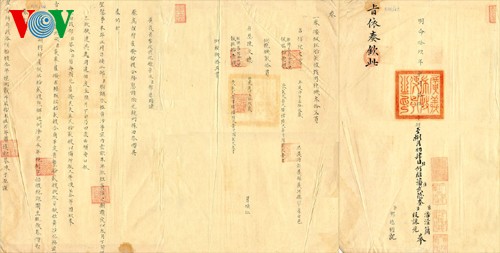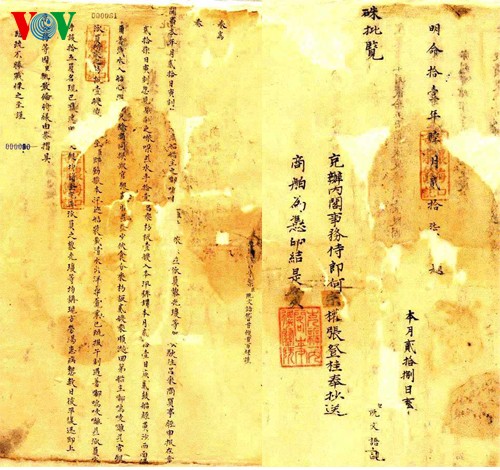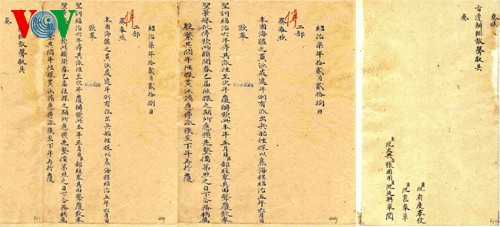(VOVworld)- Vietnam’s territorial sovereignty over its seas and islands was documented in royal documents and historical books from the Nguyen dynasty. Being aware of the importance of the seas and islands in terms of strategic military location, transport, trade and fisheries resources, the Nguyen Kings shared a consistent view on territorial sovereignty and territorial waters and they established a system of policing the seas and islands as well as the exercise of maritime sovereignty, especially over the Hoang Sa (Paracel) and Truong Sa (Spratly) archipelagos.

Imperial Document dated June 21, 19th year of Minh Menh (1838), submitted by the Ministry of Transport and Construction, reports on surveys at Hoang Sa. The document reports that survey missions were sent to Hoang Sa every year. Each year, they surveyed 12 islands.
|
The Nguyen dynasty reigned from 1802 to 1945. But 200 years before that, from 1558, Nguyen Lords including Nguyen Hoang, Nguyen Phuc Nguyen, Nguyen Phuc Chu, and Nguyen Phuc Thuan all contributed a great deal to expanding their land from Thuan Hoa in the central region to the southern region and the southern and south-western sea. When Nguyen Anh, the first King of the Nguyen dynasty, began his reign and earned his nickname Gia Long, he inherited the spirit of self-reliance, territorial integrity and territorial waters from Nguyen Lords. He was aware that national strength and royal strength were based on revenues from sea resources.
Professor Doctor Nguyen Quang Ngoc of the Institute of Vietnam Study and Development Science says that upon his coronation, King Gia Long re-established the Hoang Sa flotilla and its affiliated unit named Bac Hai flotilla with the aim of managing, protecting and exploiting Hoang Sa and Truong Sa archipelagos. Ngoc said: “King Gia Long forcefully claimed Vietnam’s sovereignty over the Hoang Sa and Truong Sa archipelagos. Many missionaries, merchants and experts on the East Sea situation said that King Gia Long placed a sole flag on the Hoang Sa archipelago”.
During his reign, King Minh Menh, the second King of the Nguyen dynasty, continually strengthened the exercise of Vietnam’s sovereignty over the archipelagos. King Minh Menh dispatched missions to Hoang Sa to survey, measure and place sovereignty markers. Associate Professor Doctor Nguyen Quang Viet, Acting Director of the Han Nom Research Institute, says:“The Imperial Archives clearly recorded that the sovereignty marker is 5 meters long and 50 cm wide. The marker planting demonstrates our sovereignty. The King also sent survey missions to draw maps, establish an administrative system and send people out to the sea to fish. All these reflect a vision of a prosperous feudal regime. Our country had never been before as large as it was under King Minh Menh’s reign”.

Imperial document dated July 19 of the 19th year of Minh Menh (1838), submitted by Quang Ngai authorities, proposes to exempt taxes for big ships on duty at Hoang Sa
|

Imperial document dated June 27 of the 11th year of Minh Menh (1830), submitted by the Cabinet, reports on the rescue of a French merchant's ship which was sunk at Hoang Sa |
In the Imperial Archives of the Nguyen dynasty, there are 10 documents under King Minh Menh’s regime that reported sovereignty activities. One document signed by the King reported that in 1830, a French ship was stranded when it was passing Hoang Sa sea. King Minh Menh assigned the Head of Da Nang’s estuary to rescue the ship, its crew and goods on board. Professor Doctor Nguyen Quang Ngoc said:“This shows the King’s responsibility and power of sovereignty over the sea that he claimed”
In addition to implementing rescue activities, drawing maps and sea routes, King Minh Menh also approved spiritual issues on the Hoang Sa archipelago. Professor Doctor Ngoc again:“It was hard and dangerous for our people to live there, so the King approved the setting up of a shrine to pray for the souls to be freed. The King also directed tree planting at sea so that faraway boats could see the trees and avoid being stranded there. The King also set up sovereignty steles and big wood steles recording his directions”.
Under King Thieu Tri’s reign, the King’s role in organizing sovereignty activities on Hoang Sa were clearly demonstrated. The King himself dispatched ships and fleets to the Hoang Sa archipelago.

Imperial document dated December 28, the 7th year of Thieu Tri (1847), submitted by the Ministry of Transport and Construction, reports: "Under the regulation, Hoang Sa sea belongs to our nation. Every year, missions are sent out there to survey to study sea routes" |
Despite many difficulties during his reign, King Tu Duc maintained sovereignty over the on Hoang Sa and Truong Sa archipelagos. Mr. Ngoc said:“In 1869, a Chinese ship from Fujian, on its way to Singapore, was stranded at Hoang Sa. King Tu Duc assigned the Ministry of Transport and Construction to go there to rescue the ship. This action shows the King’s kindness and responsibility for ensuring the safety of foreign ships operating in Vietnam’s territorial waters. It also reflects the King’s assertiveness of his sovereignty despite difficulties in the country”.
The greatest legacy that the Nguyen Kings left behind is the awareness of territorial sovereignty over the land and sea of Vietnam that stretches from Ha Giang to Ca Mau. It was also a great lesson that the dynasty left for posterity.